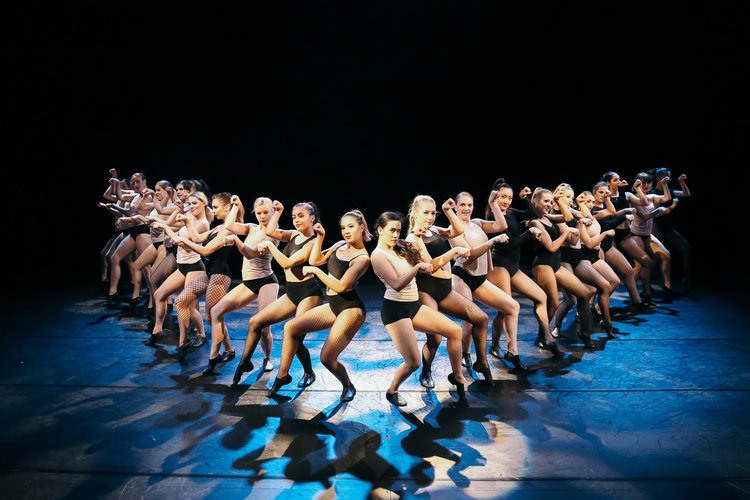Tucked away in an office at an inner urban tertiary campus in Sydney sits a woman with a 50-year track record in dance. She’s represented Australia at three world championships, choreographed routines for Olympic opening ceremonies, worked on films like Strictly Ballroom, and in 2017, she made the Queen’s Birthday Honours List for services to dance education. So, when Dr Adele Hyland AM speaks about sustainable careers in dance, she is able to perfectly embody the desired outcome of the degree course she first designed a decade ago.

Classroom to Ballroom, Team Captain Dr Adele Hyland AM (center), Australian DanceSport. Photo by Yimsky.
Indeed, it’s hard to envisage a better candidate to fulfil the role of Head of Dance at Academy of Music and Performing Arts (AMPA) or to spearhead the college’s Bachelor of Dance programme. As the only “degree” course of its kind in NSW, AMPA’s Bachelor qualification is both broadly based and grounded in the realities of a highly competitive and often fickle industry.
As Hyland notes, “We aim for sustainable careers, so we develop things that may take them along an alternative pathway, such as production skills or arts management. So we cover everything you might need to do if you’re running a dance studio or a big production, from doing the marketing and so on.”

AMPA graduate Olivia Callaghan. Photo by The Photo Studio.
This may seem counter-intuitive, but, as Hyland argues, a life in dance is not all about being on stage, and indeed side and back stage have much to offer. “I mean, we’ve even had people decide halfway through the degree that production’s more their thing, and they’ve moved into it completely,” she explains. “We had one girl who was a ballet dancer, but she injured her ankle and then started her own company; and they’ve just performed at the Melbourne Fringe Festival and she’s used our alumni in that show.”
That said, the real core of AMPA’s two-year, six-trimester, full time course is high level performance. Here again, though, the Surry Hills-based college is doing something different. “A strong thing from my point of view is that we take students with advanced skills in any dance genre,” Hyland explains. “Whereas other dance degrees focus very strongly on either ballet or contemporary, our course is open to any genre; so we have hip hop people, for instance, or Irish dancers.”

AMPA graduate Thuba Ndibali in ‘Madiba the Musical’. Photo by Serge Thomann.
The school’s commitment here is informed by Hyland’s five-decade experience as both a dancer and teacher. “My own background was not in contemporary or ballet, and I thought, ‘Well, what about all the others?’ I find that [dance courses] can sometimes be a bit elitist, which I don’t think is fair to students who have studied other genres at a high level.”
To this end, students in the Bachelor of Dance do weekly classes in jazz, tap, Latin and hip hop, as well as the usual ballet and contemporary. From Hyland’s perspective, the bubble world of ballet and contemporary can sometimes serve to restrict opportunities or prevent others from creating viable pathways in dance. “When I first wrote this course back in 2008,” she recalls, “I didn’t look at what other courses were doing; I just focused on what I felt students needed to thrive in the dance industry, regardless of the style they’d chosen.”

AMPA graduate Johnathan Vongdara. Photo courtesy of AMPA.
As the one-time champion dancer, school teacher, primary principal and now tertiary department head understands all too well, dance (like sport) can be a brutal and short career, and so the degree course aims to build potential longevity into a student’s artistry and vocation. “We don’t just teach routines,” she states. “In some courses, like a Cert IV, the kids come in and they just want to learn routines, but with the Bachelor, they want to learn choreography or the psychology of performance. It’s about going into the craft in depth, rather than just copying someone who’s modelling routines at the front of the studio.”
Yet, for all that, Hyland is probably the best ad for AMPA’s dance degree. She recalls that “in recent times, even with 50 years experience, TEQSA [Tertiary Education Quality and Standards Australia] demanded that I not be head of department here because I didn’t have a doctorate; so I went out and did it.” At this, she emits a short chuckle before adding, “So yes, that annoyed me because the experience is not really worth anything unless you’ve got a piece of paper; and that’s what I tell my students now.”
Put simply, as she likes stress to kids and parents, the bottom line benefit of the Bachelor degree is that “it has a little more clout.”
For more information on Academy of Music and Performing Arts, visit www.ampa.edu.au.
By Paul Ransom of Dance Informa.

















